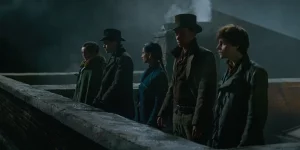Shadow and Bone is Another Example of Showrunners Failing at Adaptations
The first season of Shadow and Bone, a Netflix series based on the acclaimed trilogy by Leigh Bardugo, was fairly well-received by audiences following its release in Spring of 2021. The show follows Alina Starkov, a seventeen-year-old girl who discovers she is a Sun Summoner, the highest order of gifted people known as Grisha. SAB tells Alina’s story as she learns how to use her powers to destroy the Shadow Fold, a large dividing barrier made entirely of shadow that separates the fictional country of Ravka. 
The show made the choice to incorporate characters from Six of Crows, a duology Bardugo wrote which is set in the same world–the Grishaverse–as Shadow and Bone. With favorite characters making early appearances, impeccable casting choices, and gorgeous settings, favorable reception seemed well-earned. Not, however, for those of us who grow frustrated when faced with the changes made in book-to-screen adaptations.
There are plenty of instances where changes made in an adaptation are warranted or make the story even better, but truthfully, I had a hard time finding any of those present in SAB’s first season. And with season two’s release on March 16th, my fear of how much the story would be changed spiked dramatically.
Well. I was right to be scared.
Released on March 16th, SAB’s sophomore season is a combination of not just the second installment of the trilogy–Siege and Storm–and the characters from Six of Crows, but four other Grishaverse books as well: Ruin and Rising, Crooked Kingdom, King of Scars, and The Lives of Saints. Ruin and Rising is the third in the SAB trilogy, so merging it with its predecessor means two full books worth of content have been mashed into eight episodes. For context on the other books, Six of Crows and Crooked Kingdom take place three years after the conclusion of Ruin and Rising, and King of Scars occurs after the SOC duology.
I’ll put it simply: the choice to merge all of these people and plotlines made for an often confusing and chaotic viewing experience, especially as a reader of the books. The second book of the trilogy covers Alina and crew hunting down the mythical Sea Whip, spending a long time at sea in their search; in the third, they must hunt down the Firebird. In both of these books there is also an on-going battle with the series’ villain, the Darkling. Along with all of this material is a third storyline featuring the characters from SOC, in which the crows venture to find a sword to deliver to Alina. On a basic level, there is a lot going on plot-wise, and that contributes heavily to the confusion the show creates.
By adding plot points from books set years in the future, the show has eliminated, or at least ruined, any opportunity to create an even slightly accurate-to-the-books Six of Crows spin-off, which originally seemed to be in the cards. With the changes showrunners have made, a spin-off is likely the least of their worries. I am beginning to wonder if the show will even be renewed for a third season at all, despite its presumably hefty budget and gorgeous cinematography. The show looks beautiful, but in reality, its beauty disguises mess after mess. This is not the proverbial truck fire you can’t look away from, either–I really, really wanted to look away.
It feels pointless, a bit, to talk through where the show picks up from the first season with each storyline. Honestly, there was far too much going on for me to remember much of what was happening; I’d finish every episode–and many scenes–totally confused. Kaz, a main character in the Six of Crows books, has one main enemy in the books, Pekka Rollins, who he only defeats at the very end by tricking Pekka into believing he has buried his son alive. In the books, Pekka’s son is his only weakness, and thus what allows Kaz to destroy him. You can imagine the shock and confusion, then, of this scene being inserted halfway into the second season. How do the events of Six of Crows have any purpose if Pekka has been defeated? And, should he come back, what weakness will the writers invent for him aside from his son?
I have no difficulties remembering the books, which I read over two years ago in time for the show’s release. Perhaps this made my viewing experience worse. I often wished I had no memory of the books, if only to make the changes easier to receive.

The issue lies in the fact that the changes made to the series were never once necessary. Having Jesper and Wylan, two of the Crows, know each other from a one-night-stand; revealing Jesper’s Grisha powers almost immediately; having Alina and Mal go separate ways after talking non-stop about how all they wanted was to be together. This is the secret to adaptations, I think. The changes you make must be necessary, and they must have purpose. Maybe that means reworking a fight scene or cutting a few characters for clarity’s sake, changing a name to prevent confusion or rewriting something with inaccurate information. There are so many good reasons to make changes in an adaptation, and the SAB writers had not a single one. It goes back to the old saying: why fix something that isn’t broken?
And the Grishaverse books are undoubtedly not broken. Leigh Bardugo did not write unnecessarily or without clarity. Her writing is well-loved, highly-praised. Changing her work so much feels, almost, like a crime. (In a quote circling online, Bardugo warns fans that the adaptation is essentially well-done fanfiction. This feels a bit generous to me.) The series feels more as though, as a friend said to me, like someone was asked to explain the books and could not remember most of them or the order of any events that took place.
Shadow and Bone season two is a mess, which I imagine is only worse for fans of the books who are familiar with these characters and their arcs. Mal Oretsev, one of the three main characters in the Shadow and Bone trilogy, is a major example of a character having their personality changed between book and show. With many readers disliking Mal for most of the books, the show opted to change him and make him more likable. In turn, this takes away his ability to develop as a character. In the books, Mal becomes a better person over time. Why make him good to begin with, then?
Showrunner Eric Heisserer explained in an interview that changes made to the plot were done as a way to “keep fans on their toes and not know where we’re going.” I certainly did not know where we were going most of the time, so in that way you could say Heisserer was successful in his mission. I just don’t understand the point in doing this; I would still be on the edge of my seat for the most faithful of adaptations, simply because I love the story. I promise you don’t need to keep me guessing. Heisserer also said that the changes come “out of a necessity in that there are elements that just don’t end up translating in an adaptation,” though he never actually says what elements those are. The disgruntled part of me would argue they simply don’t exist, but, again, that’s the disgruntled part of me.
 The show still does fairly well with many viewers–IMDb episode ratings range from high 7s to low 8s. As a fan of the books, though, and someone who enjoys watching plots and character arcs develop over time, I had a hard time enjoying this adaptation. The casting feels perfect, and each actor portrays their character perfectly; the visuals are stunning and the show is beautiful to look at. I almost am more upset with the casting and cinematography being so great. It would be easier to hate this adaptation if all of it was bad, but I cannot help but give props to the cast and the crew members outside of the showrunners and writers.
The show still does fairly well with many viewers–IMDb episode ratings range from high 7s to low 8s. As a fan of the books, though, and someone who enjoys watching plots and character arcs develop over time, I had a hard time enjoying this adaptation. The casting feels perfect, and each actor portrays their character perfectly; the visuals are stunning and the show is beautiful to look at. I almost am more upset with the casting and cinematography being so great. It would be easier to hate this adaptation if all of it was bad, but I cannot help but give props to the cast and the crew members outside of the showrunners and writers.
If you love the Grishaverse and all of its characters, there’s still a chance you might really enjoy this show. It will definitely be easier for you if you don’t remember the books well and don’t mind changes made in adaptations. Even if you end up being disappointed, like I clearly was, there is still something bittersweet about seeing characters you love on the screen, especially when they are cast as well as these characters were. Take it as it is, a very, very loose retelling of a series beloved by many, and don’t get your hopes up about its accuracy. Maybe, if we’re lucky, someone else will steal the cast and start from scratch with full faith to the novels.
You can watch season two of Shadow and Bone on Netflix.

